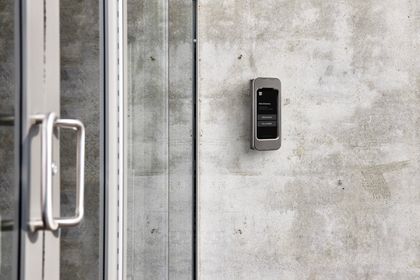More and more buildings are looking for alternatives to replace legacy intercom systems. Wireless intercom systems are quickly becoming the popular alternative. Because of growing demand, the evolution of legacy solutions, and the introduction of new systems to the market, we have put together this guide to:
- Give an overview of wireless intercom systems
- Explain why adoption has moved to wireless systems instead of wired ones
- Determine most important buying considerations
- Highlight several modern wireless intercom products
Table of contents
- How Does a Wireless Intercom System Work?
- Wireless Intercom System Benefits (and Drawbacks of Wired Intercoms)
- Choosing a Wireless Intercom System
- Best Wireless Video Intercom Systems
Related Topics:
- Best Video Intercom Systems
- Buying Considerations for Apartment Intercoms
- Best Wireless Intercom Systems for Apartments
- Buying Considerations for Office Intercoms
- Best Wireless Intercom Systems for Offices
How Does a Wireless Intercom System Work?
A wireless intercom system can work one of two ways:
- Communication over telephone lines, or
- Communication over mobile smartphones
Wireless Intercom with Telephone Lines
Traditional wired intercoms require running a wire from intercom transmitters (front door intercom) to each receiver (in-unit hardware). Over the last several decades, there has been a shift to telephone-based wireless intercoms, with products like DoorBird and Linear Systems, which allow tenants to make a wireless telephone call from the intercom system. This call can route to a landline or cell phone.
Wireless Intercom with Mobile Smartphone
As of Jan 2021, 294 million people in the US use smartphones, from a 330M population. That’s over 89% of the population that uses smartphones. As a result, people want the ability to receive visitor calls from their building to these devices that they consistently have on them.
Wireless video intercoms offer the flexibility to control visitor access from anywhere, without restriction. This is true for users, who can securely verify visitors remotely, and for administrators, who can manage access permissions and security remotely, as well.
Wireless Video Intercom vs. Telephone Line Wireless Intercoms
Wireless video intercom has several advantages over wireless intercom that uses telephone lines:
- Wireless video intercom eliminates the need for monthly telephone line fees
- Since most wireless video intercoms operate on the internet, there are other beneficial functionalities beyond visitor access
- Wireless video intercom can integrate telephone and landline calling into their system, but not visa versa
- Intercoms that operate over telephone lines use they phone keypad to trigger an unlock while wireless video intercoms use a mobile app or browser
Wireless Intercom System Benefits (and Drawbacks of Wired Intercoms)
Wireless intercoms are now becoming the preferred modern solution for two reasons:
- They are a less cumbersome, more efficient replacement for buildings looking to upgrade from a traditional wired intercom system
- They offer the best solution for buildings that were either not built with the necessary internal wiring to support legacy intercoms or new buildings that do not want to install wiring throughout
Wireless intercom systems have become more popular in recent years because of the benefits over traditional wired intercom systems, including:
- Installation: Since there are no wires that need to run between intercom units, installation is much easier. Wireless intercom installation takes less time and overhead to deploy and integrate into a building, which means there is less disruption for tenants. And, most importantly, there is no gap in security with a fast installation.
- Flexibility: Wireless intercom systems give building owners and operators the flexibility to adjust their visitor management and access control strategy. This is because a wireless solution is not restricted by the wires that transmit communication. Flexibility is important for scaling security within a single property or multiple sites and locations.
- Cost: Without the need to install wiring in each unit, wireless intercom systems are significantly cheaper than wired intercoms. This makes these solutions more financially accessible for a building that doesn’t typically have a large enough budget to implement a high-security intercom system.
Choosing a Wireless Intercom System
The most important features to consider for a wireless intercom system for buildings are:
- Remote unlock
- Visitor access
- Remote management
- Digital security
- Multi-door access
Remote Unlock With Door Release
Traditionally, apartment buildings use intercom stations that allow residents to push a button to unlock the front door for a visitor. This apartment intercom or apartment buzzer has largely gone out of style.
Popular replacements were systems like DoorKing that offered the convenience of remote unlock to trigger a door release from a telephone. This didn’t require the need to use a wall mount station. Instead, the front door to the apartment building or complex could be opened by pressing #9.
This advancement of intercom system technology expanded from largely apartment building use to a much bigger market, including commercial, enterprise, and business operations.
However, just like the apartment buzzer, this technology has become quite obsolete. Not only are upfront hardware costs expensive, ongoing maintenance and manual software updates are a recurring expense and operational burden. Finally, the effects trickle down all the way to admin tasks such as directories that need to be manually updated as tenants and occupants change.
Modern technology has again found a better solution with wireless intercom systems that use the cloud for management and operations. Using the cloud allows tenants or building occupants to use a mobile app or browser to remotely unlock doors. More than that, building security and access permissions can be managed off-site by property owners and administrators. And this technological advance has once more expanded the reach of secure access, as more access points like elevators and package rooms can be programmed for remote unlock for visitors.
Visitor Access
Wireless intercom systems often offer the ability to distribute temporary or single-use access credentials by a PIN code or QR code. When intercom systems allow users the ability to provide temporary access, the overall building experience is improved. More tangible benefits include a decrease in package theft or missing packages, and improving secure food delivery.
PIN Codes
Temporary or single-use PIN codes can be generated by the system or user, depending on the wireless intercom system. For example, PIN codes can be issued to cleaning staff or dog walkers who need intermittent access to the building. Single-use PIN codes expire five minutes after use.
QR Codes
The main difference between PIN and QR codes is diversification of use. PIN codes can be added into the special instruction section for deliveries but QR codes cannot. Visitors without a smart device also do not have the ability to access the building as QR codes are generated, sent, and received on smart devices.
Remote Management
A wireless intercom system can be operated on local software or remotely, from the cloud. A cloud-based system allows administrators to manage visitor security from anywhere. This includes changing access permissions, administering temporary access, and collecting event history logs. Wireless intercom that operates on software that needs to be installed and updated onsite does not have this functionality. It is also harder to scale operations with an onsite system.
Digital Security
Depending on the means by which a wireless intercom system operates, there will be different security measures to protect data. With on-premise systems, data is stored on local servers, so it will be important to determine where that data will live inside the building and if sufficient security practices can be put into place to protect it. When storing data in the cloud, security measures will look different in regards to protecting data and maintaining the highest level of privacy, such as SOC 2 certification.
Multi-Door Access
Depending on the system, a wireless intercom can grant access to front entrances only or to multiple doors throughout the building. Each building is different, so it is necessary to determine the needs of the tenants within the building and ensure the system offers the features that support those needs.
Best Wireless Video Intercom Systems
As mentioned, intercom systems have evolved significantly since gaining in popularity. As such, there are several variations and options on the market for buildings to choose from.
Wireless intercom systems are a great solution for boosting safety and security for:
- Apartment complexes and communities
- Condos
- Offices and enterprises
- Commercial facilities and warehouses
- Schools and university campuses
- Small offices and businesses
So, below is an overview and comparison of the best wireless intercom systems, which will help to identify the solution best fit for each unique building.
Swiftlane Video Intercom
Swiftlane is a unique wireless intercom system that uses cloud-based technology for comprehensive common area security including visitor management, package management, and access control. Swiftlane’s integrated access control uses mobile credentials, face recognition, key card, and PIN code unlock for secure building entry.
Latch Intercom System
LatchOS is a complete building access experience, so the Latch Intercom System is merely one component of the solution. While this wireless intercom system is just one viable option for a new construction project, it will not work as a retrofit intercom system, as it is only compatible with Latch Locks. Additionally, the video intercom component is not included and must be purchased separately through Latch only.
2N IP & LTE Intercom
2N is a modularized intercom system that offers both an IP and LTE connection. 2N intercom offers a competitive common area access solution, however cannot sustain efficient scalability with the legacy software it operates on. 2N does not offer remote or cloud-based system management. That, coupled with the complications and lack of consistency of a modularized solution, does not support a future-proof building or effective building operations.
Akuvox SmartPlus Intercom
Akuvox is a wireless intercom system that operates via the cloud. Akuvox intercom offers various built-in access options and multiple solutions for visitor management. The company, however, operates internationally out of China with little local support, which is necessary when dealing with physical security technology.
AlphaTouch Video Intercom
AlphaTouch, a wireless intercom product of Alpha Communications, is a basic, two-way video intercom system that integrates well with other Alpha Communication products. While AlphaTouch does offer easy integration with other products within the company, it is built and operates on a traditional intercom foundation, making additional integrations for a comprehensive building solution a challenge.
Comelit IP Video Intercom
Comelit is another wireless intercom system that comes from a line of legacy products. While the Comelit intercom system offers the basic functionality of a modern intercom, the solution operates as more of a quick fix to visitor access as opposed to a progressive, complete building solution.
Improve Your Building Security
Tell us about your building and a Swiftlane specialist will help you find the best wireless intercom system for your building.




